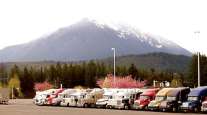Washington Opens Additional Lane on Road Destroyed by Mudslide
The road is accessible to log trucks, lumber haulers and dump trucks that service the timber industry as well as residents.
One other lane on the mountain highway that connects Oso and the larger community of Darrington to Arlington and Interstate 5 was reopened on May 31.
The second lane, which opened June 20, has a posted speed limit of 25 mph as road crews continue work.
Here's a look at the two-way traffic on SR 530 that reopened around 5 p.m. http://t.co/EmbOaIrt0t pic.twitter.com/DX4IGpLOVt
— WSDOT Traffic (@wsdot_traffic) June 21, 2014
“It’s only for a mile and half though, so, it’s all good,” said Buck Thoms, whose 13-unit fleet, Buck Thoms Trucking, is located in Darrington on the east side of the slide.
“We used to have to wait for an hour — top of the hour was westbound, bottom of the hour was eastbound,” he said of the time lost when only one lane was open.
Thoms and other timber industry haulers were hard hit by the mudslide that at first closed the highway altogether, forcing them to take long detours and rent places to park and service their trucks, which could no longer return to terminals at night.
The cost in time and fuel can never be recovered, Thoms added.
“Those things are gone forever; that’s the way it is,” he said. “It’s just gone, you can’t make that up.”
In its statement announcing the opening of the second lane, the Washington Department of Transportation reiterated that the slide so altered the landscape that the DOT must build a “new, permanent roadway that will be more resilient” into the future.
“Crews will work throughout the summer to build a permanent new section of SR 530 south of the temporarily repaired roadway,” DOT said, adding that “substantial completion” is expected by early October.
“The landslide changed the geography of the valley floor and the Stillaguamish River North Fork, increasing the chance of flooding along the corridor,” DOT said. “As a result, the roadway must be rebuilt and elevated.”
Damage to the highway devastated the economy in the timber area. To help truckers and to keep the area’s largest mill operating while the highway was closed, the state sent emergency funds to defray some of the extra fuel costs absorbed by truckers making lengthy detours.




